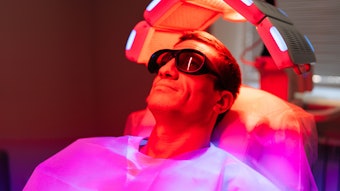
Editor’s note: This article originally appeared in the June 2014 issue of GCI magazine (www.gcimagazine.com) and is being reprinted with permission. All rights reserved.
A person’s skin is exposed to a vast array of harmful influences every day, including smog, dry air and UV rays. These harmful influences attack the skin’s unprotected surface, and with this daily exposure comes the danger of extrinsic aging factors, such as free-radical oxidation, the breakdown of matrix proteins, DNA damage and the weakening of the skin’s natural barrier—all of which can cause premature aging.
To battle against premature aging, three essential lines of protection and correction exist that are crucial for the maintenance of the skin’s natural beauty. These vital defenses include:
- Shielding against UV radiation;
- Protecting the skin’s natural lipid structure; and
- Counteracting internal damage.
First line of defense—UV protection
Minimizing the harmful effects of UV radiation is the initial step to building a shield against premature aging. To prevent UV damage, it is imperative to utilize a photostable filter that provides broad-spectrum protection to deliver uniform coverage across the entire UV light spectrum, including both UVA and UVB rays.
UVB rays directly affect the intercellular and extracellular components of the skin, leading to sunburn, inflammation and redness. UVA irradiation exerts its detrimental effect predominantly via reactive oxygen species (ROS), which cause the breakdown of lipids and proteins, and leads to DNA damage.
It is necessary to use a combination of both UVA and UVB filters in order to minimize the total amount of UV rays reaching the living layers of the epidermis. In addition to sunburn and other harmful effects caused by intense UV light, everyday exposure also leads to premature aging of the skin. To overcome this attack both on and in the skin, UV filters can be used in moderate amounts in daily beauty products, including facial moisturizers, hand creams and body lotions, to help protect against damage.
Of course, UV filters are not the only ingredients that offer protection. There are other lines of defense that are necessary, as well.
Second line of defense—barrier function
Proper skin hydration helps prevent aging, irritation and damage, and is essential for healthy-looking skin. Key elements of this include maintenance and strengthening of physiological barrier function, improvement of skin appearance, and reduction of dryness and flaking.
Water is the essential component of the skin that determines its softness and flexibility. The factors that influence the skin’s state of hydration are:
- The rate at which water reaches the stratum corneum from the layers below;
- The ability of the stratum corneum to retain moisture; and
- Prevention of water leaving the skin through evaporation.
To optimally draw water into the stratum corneum, a synergistic combination of humectants must be determined. Humectants attract moisture to the skin and simultaneously draw moisture up through the skin’s layers. The body contains some naturally occurring humectants that can become depleted due to age, and UV exposure or other environmental factors, so it is important to add biomimetic humectants to the skin to restore proper moisture flow.
Additionally, natural moisturizing factors (NMFs)—such as sodium hyaluronate, a water-binding polysaccharide—provide a water reservoir within the skin and fill up the space between the skin’s connective fibers. This helps keep the extracellular matrix components hydrated and the skin’s structure intact.
The natural skin barrier is composed of intercellular lipids that are assembled in a stacked formation, creating an impermeable barrier for the passage of water and NMFs. Complex sugars reinforce the lamellar structure of epidermal lipids, helping to maintain this stacked formation, thereby preventing transepidermal water loss (TEWL). Skin-conditioning agents and film-formers play an essential role in proper barrier function, improving moisture-retention and helping prevent the evaporation of water.
Third line of defense—normalizing cellular processes
Although each layer of the skin contains specific cells, pathways and metabolic activities, they are all interconnected. Consequently, it is imperative to normalize the appropriate cellular processes in order to protect and maintain dermal organization and the dermal-epidermal junction (DEJ) structure to provide mechanical support for a renewed epidermis.
As the epidermis ages, cellular communication decreases and, consequently, so does cell proliferation and, eventually, epidermal thickness. Cosmetic ingredients, such as yarrow extract, have shown the ability to improve intracellular communication via neuropeptides, which are responsible for the proliferation and differentiation of skin cells. This activity results in the acceleration of epidermal renewal and the improvement of epidermal thickness, therefore providing surface rejuvenation. Enhancing these critical cellular processes results in a reduction in wrinkles, an improvement in softness and radiance, and a refinement of pores.
Skin-aging also leads to the breakdown of the DEJ, which is the primary source of mechanical support for the epidermis. As the skin ages, the epithelial basement membrane at the DEJ becomes flattened, and the epidermis loses its anchoring, which causes capillaries to weaken and leak. Not only does the interaction area between the dermis and epidermis break down, but the dialogue between these two compartments also decreases. The epidermis becomes poorly nourished, thins, disorganizes and, as a result, epidermal turnover is reduced.
Proteoglycans, essential components of the DEJ, are responsible for the self-assembly and stability of these basal membranes. For reinforcement of the DEJ, perlecan and dystroglycan—a proteoglycan and its receptor—are essential for maintaining the structural integrity of the skin. They also provide endothelial strength for proper skin nourishment. Research has shown specific plant extracts, such as Polygonum bistorta root extract, are able to upregulate the expression of these skin components, resulting in an amplification of skin radiance, a reduction in wrinkles and the smoothing of overall skin texture. And by improving the structural integrity of the DEJ, skin homeostasis increases, thereby increasing radiance on both a biological and an optical level.
To achieve a complete architectural structure within the skin and improve its strength, resilience and volume, it also is imperative to stimulate key molecules located in the dermis. Research has proven the quality and functionality of these intracellular molecules is just as important as the quantity. Elastin functionality has been identified as a key player for improving skin firmness and elasticity, and dill, or Peucedanum graveolens, has been shown to stimulate a novel enzyme—lysyl oxidase-like (LOXL) enzyme—for the proper assembly of elastin and restored functionality. This results in a visible 3-D effect for improved facial contouring, increased elasticity and firmness, and improved overall smoothness and texture.
A strong line of defense
Clients must protect the skin both inside and out from the intrinsic and extrinsic damage that leads to premature aging. The three lines of defense that are essential for proper skin health include shielding against UV radiation, protecting the skin’s barrier integrity and normalizing cellular processes to counteract damage. A truly fulfilling skin care formulation must address all three lines of defense to properly meet clients’ needs, and prevent skin damage and premature aging.










